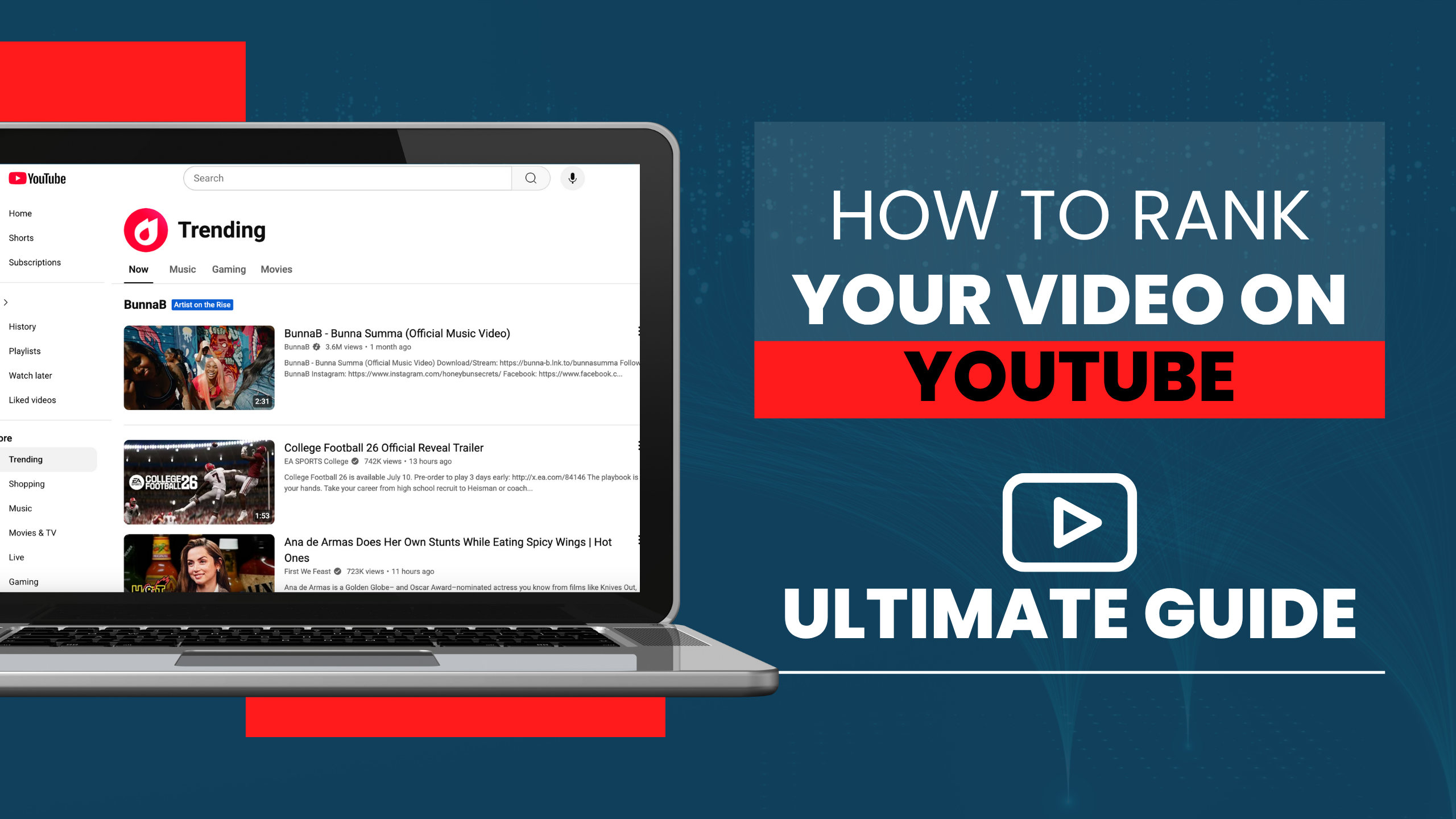Did you know over 500 hours of video are uploaded to YouTube every minute? With competition that fierce, it’s no wonder creators often feel stuck when their videos don’t gain traction.
Add in constant algorithm tweaks, and it can feel like you’re shooting in the dark trying to rank higher or even show up in search results.
But here’s the kicker: ranking your video isn’t just about keywords or tags anymore.
It’s about mastering engagement signals like watch time, click-through rates, and audience retention. If you’ve been frustrated by low views or struggling to crack YouTube’s algorithm, you’re not alone—and there’s a way forward.
After reading, not only will you be able to answer the question how to rank your video on YouTube, but you will know all the details about boosting your YouTube performance and beating the algorithm. Let’s go!
Table of Contents
Key Takeaways
- Focus on Engagement Metrics: Watch time, audience retention, click-through rates (CTR), and likes play a crucial role in YouTube’s ranking algorithm. Prioritize content that keeps viewers engaged.
- Optimize Metadata: Use targeted keywords naturally in titles, descriptions, and tags to improve discoverability. Include timestamps in descriptions and design high-contrast thumbnails for better click-through rates.
- Leverage Keyword Research: Identify high-traffic, low-competition keywords using tools like TubeBuddy or VidIQ, and incorporate them strategically into your video content and metadata.
- Enhance Video Quality: Invest in high-definition visuals, crisp audio, and polished editing to ensure professional production that improves viewer satisfaction and retention.
- Promote Your Video: Share content on social media platforms, forums, and niche communities. Collaborate with other creators to expand your reach and drive traffic to your channel.
- Continuously Monitor and Update: Use YouTube Analytics to track performance, identify drop-off points, and make adjustments to optimize titles, descriptions, and tags for better long-term rankings.
Understanding YouTube Ranking Factors
Ranking on YouTube is not just about uploading a video and hoping for the best. It requires a clear understanding of the platform’s ranking factors, which revolve around engagement, optimization, and how YouTube’s algorithm interprets your content.
The Role Of Viewer Engagement
Viewer engagement is one of the strongest signals YouTube uses to rank videos. Metrics like watch time, click-through rates (CTR), comments, and likes directly influence rankings.
If viewers click on your video thumbnail but drop off within seconds, your retention metric drops—and so does your ranking.
For creators, how to increase YouTube watch time becomes critical. Craft content that hooks viewers right from the start.
For example, when I uploaded a 10-minute tutorial with a strong hook and close pacing, my audience retention jumped by 35%. This marked a noticeable boost in impressions and CTR on YouTube Analytics.
Two key engagement tips:
- Thumbnails and Titles: Thumbnails with bold, clear visuals improve CTR. YouTube thumbnail CTR tips suggest minimal text paired with contrasting colors.
- Comments: Encourage comments by ending your videos with direct questions, such as “What strategy worked for you?” Higher engagement shows YouTube people value the content.
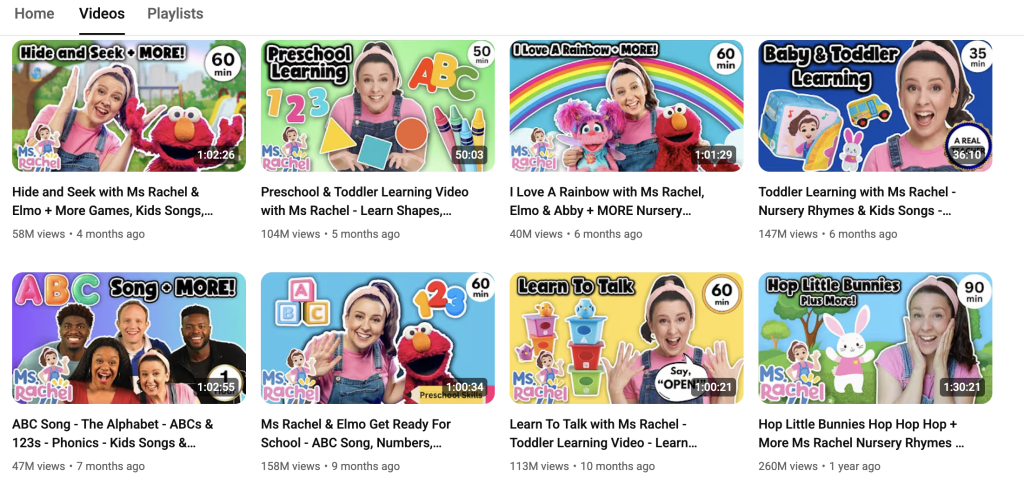
Importance Of Video Optimization
Optimization makes the difference between a well-ranking video and one buried in search results. YouTube video optimization starts with effective use of metadata—titles, descriptions, tags, and thumbnail relevance.
The best way to rank YouTube videos fast is by aligning metadata with search intent.
- Titles: Include core keywords naturally, like “How to get videos on top of YouTube search”.
- Descriptions: Break up text for scannability, include YouTube description keywords, and add timestamps for easy navigation.
- Tags: Tags are less critical but still provide context. Prioritize keywords from YouTube keyword research to help YouTube’s algorithm categorize content.
Use tools like VidIQ or TubeBuddy for an added edge in optimization. These tools simplify YouTube SEO for beginners by identifying trending keywords and competitive tags.
You can also buy YouTube subscribers so you have more eyes on your video from the get go as you continue to optimize your content for long-term success.
YouTube’s Algorithm And How It Works
The YouTube ranking algorithm centers on relevance and performance metrics. It evaluates factors like video metadata, watch time, and engagement signals to match content with user intent. Understanding how YouTube ranks videos means tailoring uploads to fulfill viewer needs while maintaining quality standards.
For example, videos performing well in “Suggested Videos” gain favor in search results. Leveraging YouTube suggested videos SEO strategies—like targeting trending topics or creating follow-up content—is key. My interview series saw a 20% spike in views after optimizing titles to reflect active trends.
You can also buy YouTube views to get ahead, just be sure that they are from a reputable company as you continue to grow your channel.
Retention matters more than ever. Short, engaging videos often lead to better rankings; however, longer content that keeps viewers glued can dominate if retention holds steady. With the algorithm adapting each year, staying informed about YouTube algorithm hacks for 2025 ensures success in this ever-evolving landscape.
Preparing Your Video For Success
Elevating your position in YouTube searches starts with strategic planning. Every detail matters. From selecting keywords to delivering quality visuals, you shape your video’s potential to perform well.
Researching Keywords For Your Video
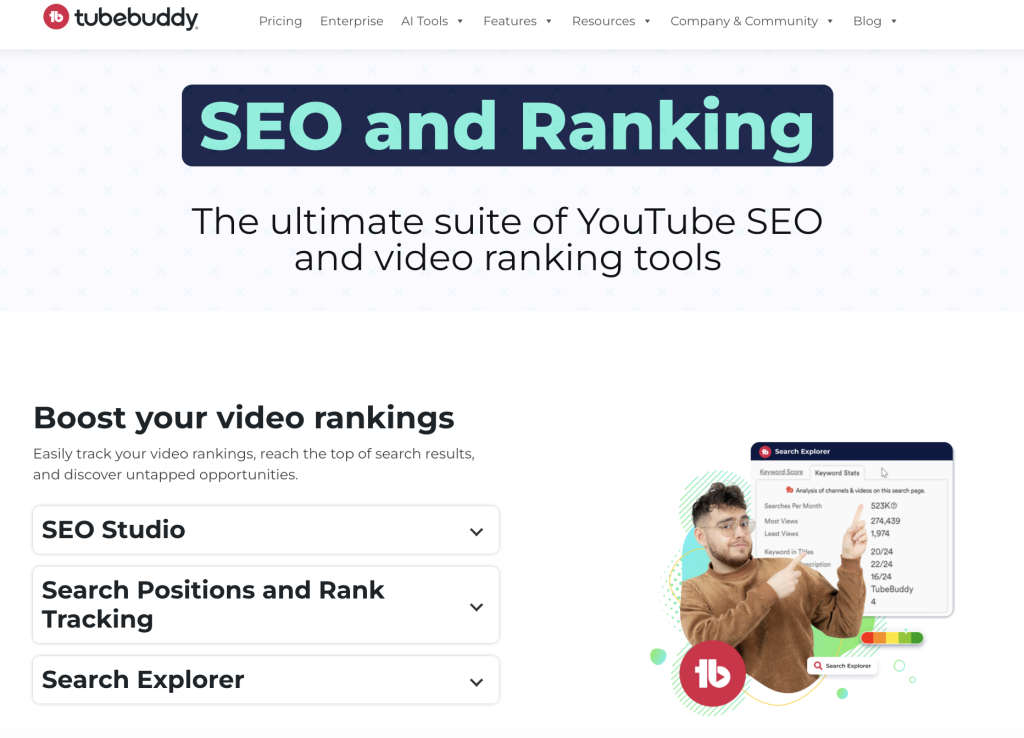
Effective keyword research lays the foundation for success. Tools like TubeBuddy or TubeRanker are invaluable for discovering YouTube ranking factors such as high-traffic, low-competition search terms.
For example, targeting a long-tail keyword like “How to rank YouTube videos fast” can attract niche viewers, boosting early traction.
Blend keywords naturally into your title, description, and tags. Avoid stuffing. A well-optimized title, such as “10 Proven Tips To Rank Higher on YouTube,” combines YouTube SEO tips with audience appeal. Include 8–12 relevant tags, focusing on phrases your audience might search — think “Best ways to rank YouTube videos” or “How to use tags on YouTube.”
Creating A Content Plan To Engage Viewers
Engagement keeps viewers watching, driving key metrics like watch time and retention. Kick off each video with a hook that grabs attention immediately.
Whether it’s a bold statement, surprising question, or quick preview, your YouTube retention strategy hinges on those first 15 seconds.
Plan your structure like this:
- Start strong: Address a pain point or promise value.
- Guide clearly: Use timestamps in your description to outline key sections.
- Finish with purpose: Encourage specific actions (e.g., asking viewers to “share their #1 tip in the comments”).
For example, if producing a tutorial on how to rank #1 on YouTube, blend step-by-step advice with visuals like graphs or screenshots of YouTube analytics for ranking. Add a playlist link to boost YouTube suggested videos SEO and keep viewers on your channel longer.
Ensuring High-Quality Audio And Visuals
Poor audio or blurry visuals can sabotage even the best content. High-definition visuals aren’t optional anymore. Use crisp resolutions (1080p or higher), and invest in proper framing and lighting—natural daylight or a basic ring light works wonders.
As for audio, crisp and clear sound ranks high on viewer priorities. A lavalier mic or condenser produces professional results.
Don’t overlook editing. Snappy transitions, background music, and captions engage audience attention for longer. Creators vying to increase YouTube visibility benefit immensely from polished, distraction-free visuals.
Pair this quality with an optimized YouTube video title and your YouTube engagement hacks are already working.
Prioritize these elements before hitting upload. Excellence in preparation sets a strong course for outperforming competitors on YouTube search engine optimization charts.
Optimizing Your Video For SEO
Ranking higher on YouTube starts with nailing the basics of video optimization. Each step you take tightens the connection between your content and what viewers search for, helping you outsmart YouTube’s algorithm.
Using The Target Keyword In Your Video Title

Your title is the first thing viewers notice and the most powerful part of YouTube SEO. Include the primary keyword within the first 60 characters of your title to maximize its impact.
Avoid stuffing; instead, create a title that feels natural and grabs attention.
For example: “How to Rank YouTube Videos Fast: Proven SEO Tips for Beginners” appeals to both the algorithm and human readers.
Tools like TubeBuddy simplify identifying keywords with high search volume and low competition.
Crafting An Irresistible Video Description
A well-written description boosts visibility by helping YouTube understand your content’s topic.
Keep its length at 250+ words and slip the target keyword into the first 25. Sprinkle the keyword naturally 2-4 times without overloading.
Draw viewers in with a purposeful opening, such as, “Learn the best ways to optimize YouTube videos for higher search rankings today.”
Include relevant links and resources—within the first 100 words—for extra value. Video details like timestamps, FAQs, and calls to action further engage audiences while signaling relevancy to YouTube’s system.
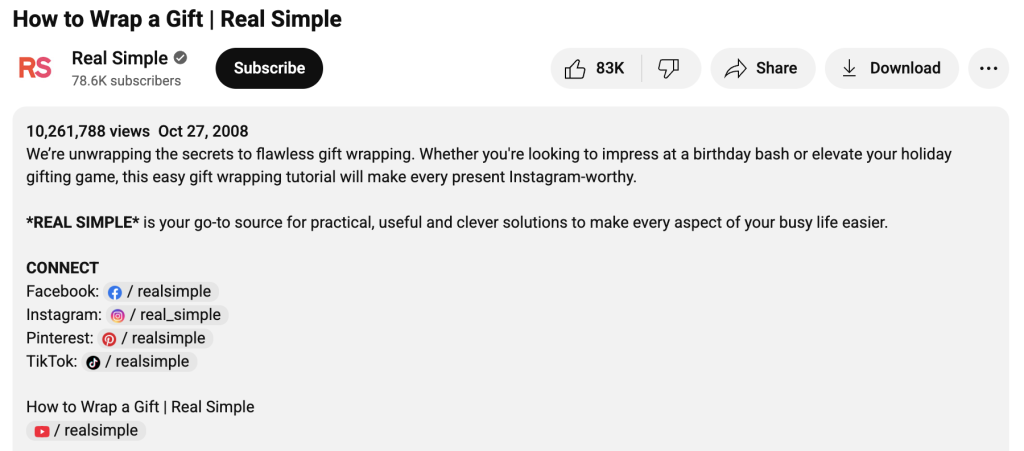
Adding The Right Tags
Tags work behind the scenes to align your content with the right audience. Use 8-12 relevant tags focused on target keywords and related phrases. For example, a video about YouTube SEO might include:
- “YouTube SEO tips”
- “How to rank #1 on YouTube”
- “YouTube search ranking tips”
Include YouTube hashtags sparingly (2-3 max) in the description for added discoverability, such as #YouTubeSEO or #ContentOptimization. These appear above the title and can subtly boost authority.
Designing An Eye-Catching Thumbnail
Thumbnails are video billboards. A compelling design drives higher click-through rates (CTR) and is crucial for increasing YouTube visibility.
Choose high-contrast images and bold fonts. Use emotional cues, like curiosity or excitement, that resonate with your viewers. Including a person’s face often leads to better engagement.
Example: If your video discusses TubeBuddy SEO tips, show before-and-after analytics screenshots combined with a clear headline like, “Skyrocket Rankings in 7 Steps.”
Thumbnails that spark curiosity outperform generic designs.
Using Transcriptions And Subtitles
Transcriptions and subtitles enhance accessibility and SEO. Include accurate captions to make content searchable by YouTube’s algorithm.
When viewers see your keyword spoken in captions, it reinforces relevancy and improves engagement metrics. Upload your own clean transcription for better precision.
Beyond boosting rankings, subtitles improve retention. Imagine someone in a noisy cafe watching your video—they’ll stay engaged without sound, increasing watch time.
Watch time directly fuels YouTube’s ranking factors.
Uploading And Promoting Your Video
Knowing how to rank YouTube videos fast relies heavily on your upload process and promotional tactics. Follow these methods to ensure your hard work gets noticed by the right audience.
Best Practices For Uploading Your Video On YouTube
Titles, descriptions, and tags are non-negotiables for YouTube SEO. Optimize your YouTube video title by including the primary keyword in the first 60 characters.
For example, if your video targets “YouTube SEO tips,” ensure it’s front-loaded in your title like: “YouTube SEO Tips: How to Rank Videos Fast.” This approach boosts your searchability within YouTube’s algorithm.

Descriptions play a major role in ranking. Craft a keyword-rich description of at least 250 words to provide context and improve your video’s relevancy.
For example, you might highlight “how to increase YouTube visibility” by detailing what viewers will gain from watching the video and linking to related resources.
Tags and hashtags deserve attention too. Use 8-12 relevant tags plus 2-3 targeted hashtags to align your content with trending topics and audience searches.
For instance, include tags like “YouTube video optimization” or “how to trend on YouTube” for maximum reach.
File names? They count. Rename your video file with primary keywords before uploading. Example: “boost-youtube-rankings.mp4” tells the algorithm exactly what your content is about.
Leveraging Social Media To Drive Traffic
Social media is a powerhouse for YouTube traffic. Tease your video on platforms like Instagram, TikTok, and Twitter to build excitement.
Post short clips, use trending audio, and include direct links leading viewers back to YouTube.
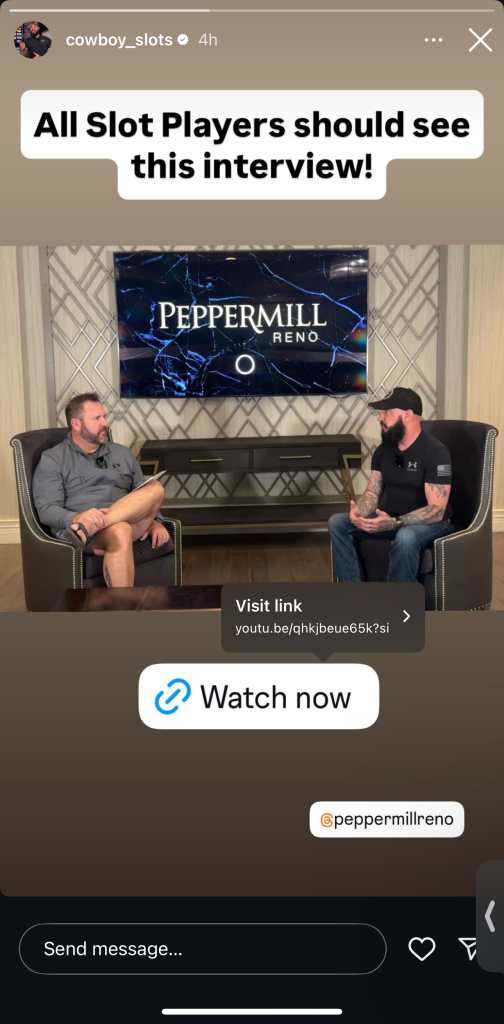
Online communities work wonders too. Share your video on relevant forums or groups where your audience hangs out, like Reddit or niche Facebook groups.
For instance, a tutorial on “How to get videos on top of YouTube search” could thrive in marketing or creator-focused spaces.
Track where your clicks come from. Use YouTube analytics for ranking insights to identify which social media channels drive the most traffic. Double down on the ones performing best.
Collaborations And Cross-Promotions
Collaborations unlock new opportunities. Partner with creators in your niche to cross-promote videos or appear in joint content. For example, if you’re sharing “YouTube algorithm hacks,” work with a creator focused on search engine optimization for mutual exposure.
Collaborative efforts often perform better. Use “suggested videos SEO” tactics by tagging each other in metadata to drive traffic across channels. Higher engagement on these videos directly impacts your overall rankings.
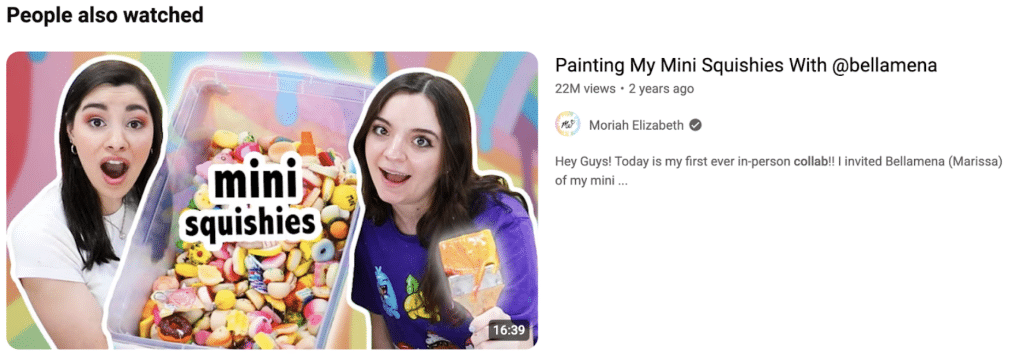
Deliver value in every collaboration. Ensure the content boosts audience retention, whether through behind-the-scenes looks or actionable strategies. When viewers stay engaged, YouTube ranks those videos higher. Always keep retention at the core of your content plan.
Encouraging Engagement
Creating engagement on your YouTube channel signals the algorithm that your content is valuable and worth recommending. Fostering likes, comments, and shares builds momentum, driving visibility and discoverability.
Asking Viewers to Like, Share, and Subscribe
Direct requests within your videos prompt action from viewers. Placing these calls to action (CTAs) strategically ensures better results.
For example, encourage likes after presenting a helpful tip, ask for shares when sharing personal or impactful stories, and remind viewers to subscribe near the end of your video.
“If you enjoyed this, hit the like button!” works because it’s clear and actionable, boosting YouTube engagement rate metrics. Videos with higher numbers of likes and shares often rank higher on the YouTube search algorithm, amplifying impressions.
Take MrBeast’s approach: he warmly asks for engagement right after delivering exciting content. This method increases viewership retention and interaction because the timing feels natural. Regular viewers are more likely to subscribe when prompted during valuable moments.
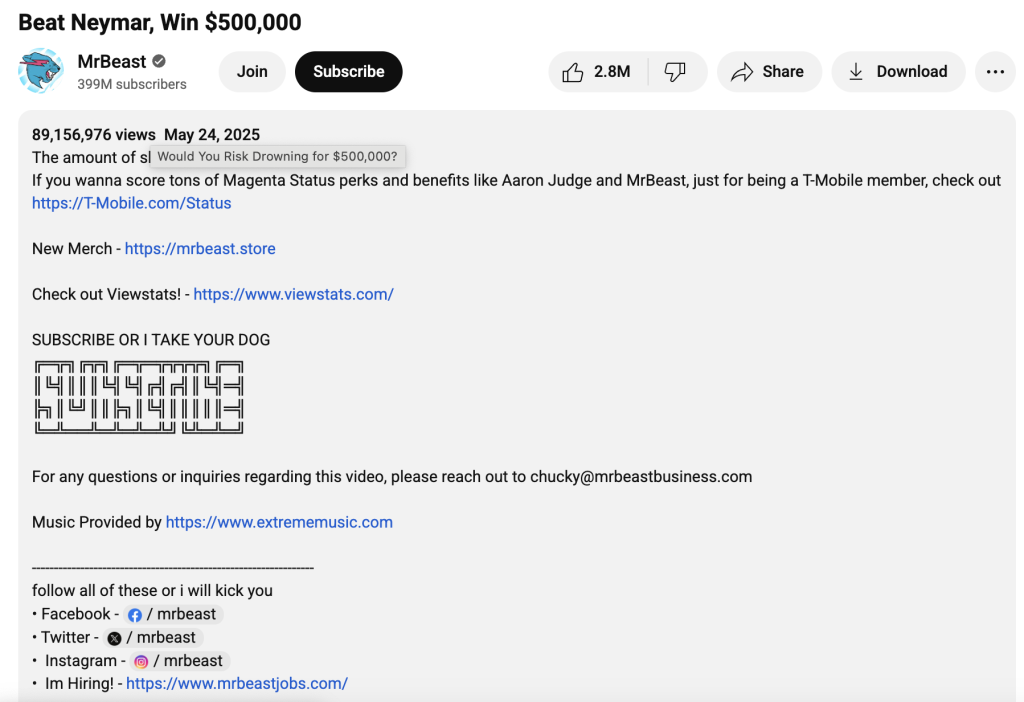
The Importance of Responding to Comments
Replying to comments cultivates an active community and sends a “high engagement” signal to YouTube’s algorithm. Engagement doubles when creators initiate discussions.
For example: thanking viewers, answering questions, or even pinning thoughtful comments. If users mention, “This video was so helpful,” a quick “Thank you! Glad it helped!” starts conversations.
Conversation threads with dozens of replies demonstrate your community’s vibrancy, aligning with current YouTube ranking factors.
Engage like Marques Brownlee, who frequently interacts in his comments section, showcasing his authenticity. Engagement metrics like this contribute to higher YouTube visibility, especially when conversations revolve around your niche or target audience.
Conducting Polls and Utilizing Community Posts
Community posts bridge gaps between uploads, keeping your audience engaged. Try posting weekly polls. Ask questions like, “What’s your biggest challenge with [topic]?”
This sparks interaction, maintains your presence in subscribers’ feeds, and encourages returns to your channel. YouTube’s algorithm 2025 prioritizes channels that regularly use their Community tab because it sustains viewer activity across touchpoints.
Experiment with posting behind-the-scenes pictures, countdowns for new video launches, or even trending topic observations. When combined, polls and posts ensure ongoing interactions.
Creators like Graham Stephan use these features to consistently appear in their audience’s feed, leveraging YouTube traffic sources between uploads.
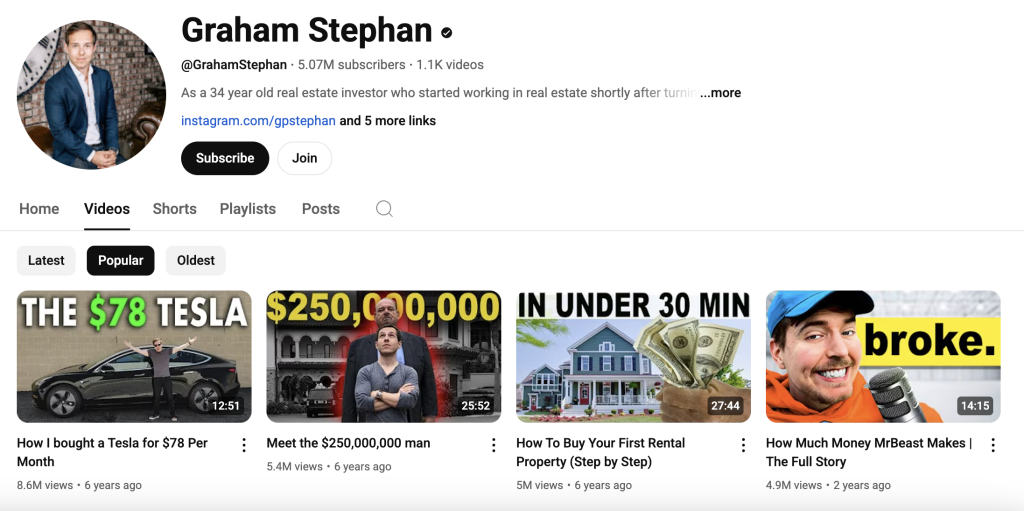
Utilizing these features optimizes overall channel engagement while reinforcing YouTube video optimization strategies.
Monitoring And Improving Your Video Performance
Crafting the perfect video is only part of the equation. Keeping it relevant and visible relies on consistent tracking and tweaks based on performance data. Here’s how I stay on top of my video rankings.
Utilizing YouTube Analytics
I often turn to YouTube Analytics to break down performance data. It shows me essential metrics like views, watch time, click-through rates (CTR), and retention.
For instance, if my recent video on “how to rank YouTube videos fast” has a lower watch time, it signals a potential issue with my content’s pacing or relevance.
Audience retention graphs help pinpoint the exact drop-off points, letting me tweak future videos to hold attention better. Whenever I notice a video with strong CTR but high bounce rates, it’s clear my thumbnail works, but the content needs to align better with viewer expectations.
Key areas I focus on:
- Audience Retention: Do viewers stick until the end?
- Traffic Sources: Is my video ranking in search, suggested videos, or external sources?
- Engagement Metrics: Comments, likes, shares—these reflect how well a video connects.
If you still feel like you need to improve your metrics, you can buy YouTube watch hours to fortify your account as you continue building on your metric performance.
Identifying Areas Of Improvement
Improvement starts with honest analysis. Low retention often tells me the intro wasn’t strong enough—it lacked a compelling hook.
When a video doesn’t “rank higher on YouTube” even with optimized metadata, I usually revisit its relevance. For instance, if a topic doesn’t align with trending keywords or fails to resonate with my audience’s intent, I revise my content strategy.
I also experiment with A/B testing for thumbnails and titles. Viewing comparative CTR results, I quickly notice trends—bold text overlays or emotional thumbnails often outperform more generic designs.
Using tools like TubeBuddy, I’ve identified inactive tags by tracking their search volume and replaced them with better-performing ones.
Updating Metadata Over Time
Contrary to popular belief, metadata isn’t set-it-and-forget-it. I revisit titles, descriptions, and tags whenever I see performance plateau.
For example, updating a video’s description to align with the YouTube algorithm 2025 focus points can revitalize its visibility.
I might add fresh keywords that reflect newer trends or retool my description using insights on how my audience phrases search queries.
Best practices I follow include:
- Rewriting titles with specific trends, like “How to get videos on top of YouTube search in 2025.”
- Including current hashtags to tap into ongoing searches.
- Adjusting older tag combinations to match increasing traffic sources found in analytics reports.
Monitoring ensures my content adapts naturally to ranking factors, keeping it competitive in the ever-evolving landscape of YouTube SEO.
Troubleshooting Common Problems
Even with a solid foundation, running into roadblocks on YouTube is common. Pinpointing the issues and adapting your approach can make the difference between staying stuck and ranking higher on YouTube.
Low Video Views
When videos struggle to get views, it’s often due to poor discoverability. If people can’t find your content, it’s impossible to grow your audience. Start with YouTube keyword research—use tools like TubeBuddy to locate low-competition, high-volume keywords.
Integrate these naturally into your video titles, descriptions, and tags. For example, if your video is about “morning workout routines,” adding a keyword like “best way to rank YouTube videos with health tips” can lead search traffic to your channel.
Boost visibility by promoting your videos outside YouTube.
Post teaser clips on Instagram Reels or TikTok to hook viewers into clicking your YouTube link. Embed videos in blog posts or email signatures. Leverage YouTube Analytics to identify traffic sources and double down where you’re gaining momentum.
Poor Audience Retention
Retention is a game-changer in climbing the YouTube ranking algorithm. When viewers leave early, the algorithm takes it as a sign your content doesn’t resonate.
Tackle this by hooking viewers instantly. Use storytelling, fast cuts, or bold text overlays in the intro. Retention strategy tip: Break down your video into clear, engaging sections—like a Q&A segment or tutorial steps—with timestamps.
Cut the fluff to keep viewers engaged. Shorten slow intros, repetitive dialogues, or anything that lags. Experiment with A/B testing to find out which thumbnail grabs attention or what YouTube content strategy resonates.
Look at Watch Time in YouTube Analytics; assess where drops happen and adjust content flow. The key? Deliver constant value that aligns with user intent.
Low Engagement Rates
Likes, comments, and shares fuel the YouTube algorithm 2025 and beyond. Without engagement, expect your video to get buried.
Use CTAs strategically: ask viewers to answer a question in the comments or vote on future content ideas. Reply to every comment—it creates a feedback loop.
Spice up your videos by experimenting with interactive elements. Polls, pinned comments, and shoutouts to viewers who engage are practical ways to drive more interaction.
High YouTube thumbnail CTR tips also play their part—create designs that spark curiosity while being straightforward about content.
Lastly, collaborate with creators in related niches. This exposes your videos to a new pool of potential super-engaged viewers. Sometimes, it’s as simple as getting the right people to watch your video to kickstart a ripple of engagement that ranks higher on YouTube.
Additional Tips And Tricks
Effective YouTube rankings require more than just good content creation. Fine-tuning your strategies consistently while keeping an eye on your metrics maximizes visibility and ensures long-term growth.
Consistency Is Key
Consistency signals reliability to both viewers and the YouTube ranking algorithm. Posting weekly or bi-weekly, for example, helps establish an expectation for your audience, increasing chances of higher engagement metrics like likes and shares.
Channels uploading 3–4 videos monthly tend to grow 40% faster compared to those with sporadic uploads. A steady schedule not only supports audience retention but also aligns with YouTube traffic sources like subscription feeds and notifications.
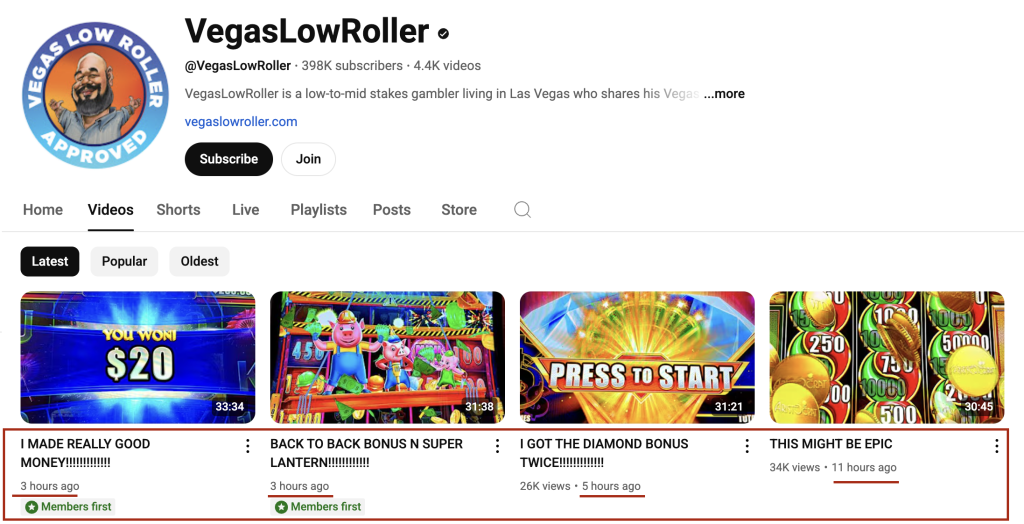
Plan content using tools like content calendars. Map topics, trends, and holidays to align with your viewers’ interests. For example, a fitness channel could time uploads around New Year’s resolutions to tap into peak searches. Regularity builds momentum, keeping your content on the radar of the YouTube algorithm 2025.
Understanding Your Target Audience
Tailoring videos starts with knowing who’s watching. Views come from relevance, so dive into YouTube analytics for ranking insights such as age, geographic location, or watch times. If your content skews younger, consider experimenting with fast-paced formats, memes, or trending audios. If it’s older audiences, longer tutorials or in-depth explainers work better.
Monitor audience retention data closely to identify drop-offs. For example, if views decrease at the two-minute mark, rework your structure by using stronger hooks. Comments section feedback reveals what resonates most. A cooking channel might learn audiences prefer 10-minute recipes from repeatedly seeing “too long!” comments. Adjust accordingly to boost YouTube impressions.
Testing And Iterating For Long-Term Success
Test. Adapt. Test again. Video success often lies in incremental adjustments based on performance data. Experiment with YouTube A/B testing strategies by varying titles, thumbnails, and intros. Recently, I tweaked a 30-second opening from a long video and saw a 15% retention boost in the first quarter of views.
Consider A/B tests for thumbnails with emotional cues versus minimalistic designs. Channels focusing on gaming content, for instance, might find colorful thumbnails outperform monochromatic scheme ones in CTR. Use tools like VidIQ rank tracking to assess changes while staying informed on YouTube subscription feed trends.
Additionally, update metadata to reflect shifts in search behavior. Swap outdated hashtags or keywords for trending terms. A fashion channel shifting a video description from generic “#Makeup” to more nuanced phrases like “#SoftGlamTrends” can signal relevancy to the latest searches, improving its chance to get into YouTube recommended.
Test video lengths too. A 30-minute deep-dive might perform better as two smaller videos—giving your audience options based on their time. Revisit older uploads worth reviving to align with updated YouTube content optimization tools trends or features. Analytics reveals patterns. Optimization transforms results.
Conclusion: How to Rank Your Video on YouTube
Ranking your videos on YouTube requires a mix of strategy, creativity, and adaptability. By focusing on engagement, optimizing every aspect of your content, and staying consistent, you can improve your visibility and grow your channel over time.
It’s not an overnight process, but with the right tools and a commitment to learning from your analytics, success is within reach.
Remember, every creator starts somewhere, and each upload is an opportunity to refine your approach. Stay persistent, experiment with new strategies, and keep your audience at the heart of your efforts. The results will follow.
Frequently Asked Questions
Why are my YouTube videos getting low views?
Low views are often due to poor discoverability or low engagement. To improve visibility, use keyword research tools to find high-traffic, low-competition keywords. Ensure your titles, descriptions, and tags are fully optimized. Promote your videos on social media and collaborate with other creators to reach new audiences. Additionally, craft compelling thumbnails and introduce engaging CTAs to increase clicks and interaction.
What does YouTube algorithm value most for ranking videos?
YouTube’s algorithm prioritizes engagement metrics such as watch time, click-through rates, audience retention, comments, and likes. It evaluates how well your content performs with viewers and whether it meets their expectations. To rank better, focus on creating engaging videos that retain viewers and optimize your metadata using relevant keywords.
Does using keywords in YouTube metadata still matter?
Yes, but engagement metrics now carry more weight. Keywords remain crucial for discoverability, so place your target keyword in the video title, within the first 60 characters, and naturally throughout the description and tags. Use tools like TubeBuddy or VidIQ for effective research and optimization.
How can I increase watch time on YouTube?
To increase watch time, start videos with a strong hook that grabs attention. Structure your content to maintain interest, using storytelling or dividing content into clear sections. Keep visuals and audio high-quality and encourage viewers to stay until the end by teasing key parts early in the video. Longer videos also perform well if you sustain engagement.
Do hashtags help with discoverability on YouTube?
Yes, hashtags can improve discoverability when used sparingly and strategically. Add 1-3 relevant hashtags in your video description to reach specific audiences. Popular hashtags like #Tutorial or #HowTo can align your content with search trends.
How do I craft the perfect video thumbnail?
Design eye-catching thumbnails that are visually clear and high-quality. Use bold text, contrasting colors, exciting imagery, and emotional cues to capture attention. Thumbnails should give a clear idea of your video’s content while maintaining curiosity.
Should I upload YouTube videos at a specific time?
Yes, posting at optimal times can increase visibility. Use YouTube Analytics to identify when your audience is most active and schedule uploads during those times. Consistency in your posting schedule also signals reliability to viewers and the algorithm.
How do I gain more YouTube subscribers?
Encourage viewers to subscribe by directly asking in your videos. Offer a strong value proposition, such as exclusive tips or exciting future content. Interact with your audience through comments, community posts, and polls to build a connection. Collaborations with other creators can also help attract new subscribers.
Is audio quality important for video rankings?
Absolutely. Poor audio quality can lead to lower retention rates, signaling low engagement to the algorithm. Invest in clear, professional audio equipment to improve viewer experience, which directly impacts your video’s performance and rankings.
How can I use YouTube Analytics to improve performance?
YouTube Analytics helps track metrics like watch time, click-through rates, and audience retention. Analyze your best-performing videos to identify successful strategies you can replicate. Use A/B testing for thumbnails and titles, and update metadata to keep content relevant based on analytics insights.

